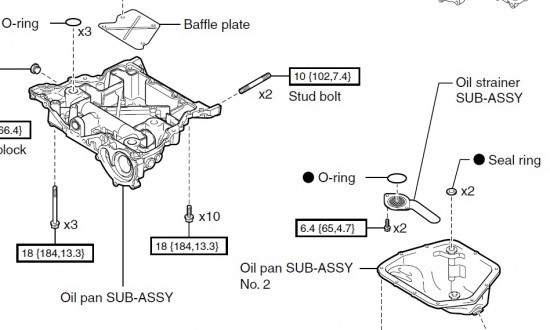Category : BRZ / FR-S
Back to Blog
Share This
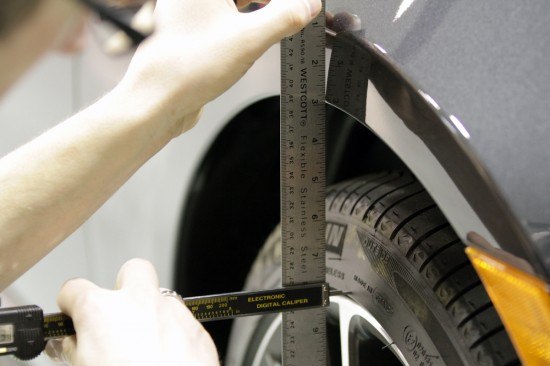 As I mentioned, we all want to toss the Prius tires for something wider and stickier. The question is, how wide can we go? As expect with a RWD car, there is more room in the rear compared to the front. The car comes with 17"x7" wheels with a 48mm offset and 215mm wide tires.
Starting with the front there is enough room to push the wheel about 10mm out toward the fender with no issues clearing anything. 15mm starts to push it close to the fender where it may rub. Going from the rim to the inside of the car, the strut is going to be the limiting factor here. There is about 12-14mm of extra room to move the wheel toward the inside. With this you can guess that an 8" wide wheel will easily work in the front. The next thing is offset. We tested a 48mm offset wheel that was 8" wide and it was very close to teh strut. While this works, it still leaves the wheel pushed to the inside of car just a bit. A 40-42mm offset 8" wide wheel would be perfect for the front of the car. If you go with an 8" or even an 8.5" front wheel, a 245 wide tire should fit no problem. The only thing is wider may start to take away some of that lovely steering feel. Also going with a smaller offset wheel (pushing it to the outside more) could effect some of the feel as you are moving the centerline of the tire out as well.
The rear is a different story. From the wheel to the fender, there is a good 16mm of safe room. On the inside, there is about 35mm of safe room. This means a 10" wide wheel would easily fit. I think with the right offset, you could go to 11" wide wheels enabling 305 wide tires to fit. Again, this may start to ruin the car performance creating an imbalance front to rear. At least until we start to add some big power, this could be the case.
With the wheels and tires being looked at, I grabbed my camber gauge to meaure that as well. Interesting for sure.
As I mentioned, we all want to toss the Prius tires for something wider and stickier. The question is, how wide can we go? As expect with a RWD car, there is more room in the rear compared to the front. The car comes with 17"x7" wheels with a 48mm offset and 215mm wide tires.
Starting with the front there is enough room to push the wheel about 10mm out toward the fender with no issues clearing anything. 15mm starts to push it close to the fender where it may rub. Going from the rim to the inside of the car, the strut is going to be the limiting factor here. There is about 12-14mm of extra room to move the wheel toward the inside. With this you can guess that an 8" wide wheel will easily work in the front. The next thing is offset. We tested a 48mm offset wheel that was 8" wide and it was very close to teh strut. While this works, it still leaves the wheel pushed to the inside of car just a bit. A 40-42mm offset 8" wide wheel would be perfect for the front of the car. If you go with an 8" or even an 8.5" front wheel, a 245 wide tire should fit no problem. The only thing is wider may start to take away some of that lovely steering feel. Also going with a smaller offset wheel (pushing it to the outside more) could effect some of the feel as you are moving the centerline of the tire out as well.
The rear is a different story. From the wheel to the fender, there is a good 16mm of safe room. On the inside, there is about 35mm of safe room. This means a 10" wide wheel would easily fit. I think with the right offset, you could go to 11" wide wheels enabling 305 wide tires to fit. Again, this may start to ruin the car performance creating an imbalance front to rear. At least until we start to add some big power, this could be the case.
With the wheels and tires being looked at, I grabbed my camber gauge to meaure that as well. Interesting for sure.
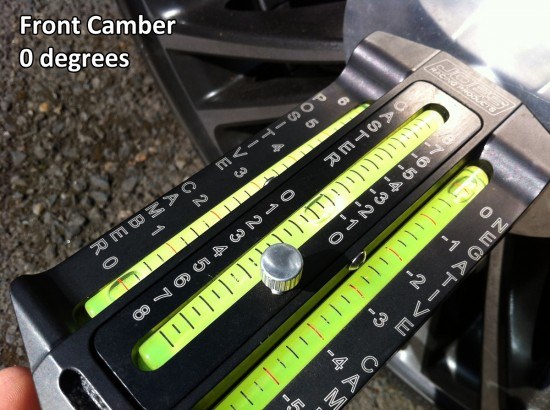
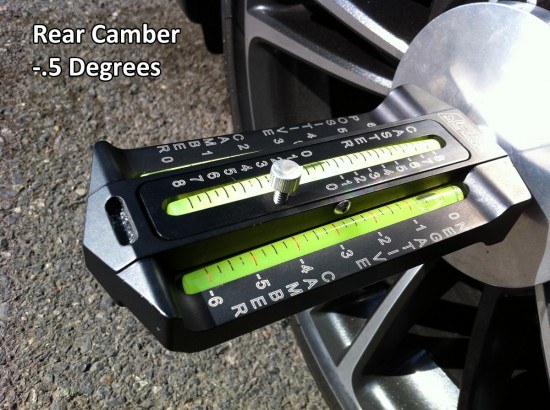 For now, until we add some big power, going with the same front and rear wheels may be the best option. Then again, that staggered look would be really cool. For me, I don't want to ruin the fun factor of this car, so pushing the wheel and tire size to the limit isn't what I plan to do.....yet.
For now, until we add some big power, going with the same front and rear wheels may be the best option. Then again, that staggered look would be really cool. For me, I don't want to ruin the fun factor of this car, so pushing the wheel and tire size to the limit isn't what I plan to do.....yet.
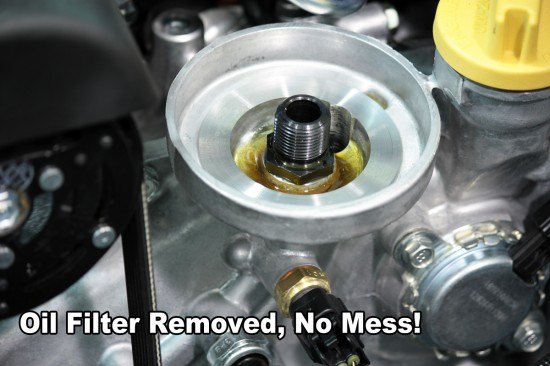 This may sound funny but the second thing I did was take off that oil filter. I was dying to see what would really happen. Would it dump oil everywhere? Would it make for a huge mess? Would dirt get sucked down in to the oil? No, No and No. Super clear, super simple, and I can't wait to do an oil change!
This may sound funny but the second thing I did was take off that oil filter. I was dying to see what would really happen. Would it dump oil everywhere? Would it make for a huge mess? Would dirt get sucked down in to the oil? No, No and No. Super clear, super simple, and I can't wait to do an oil change!
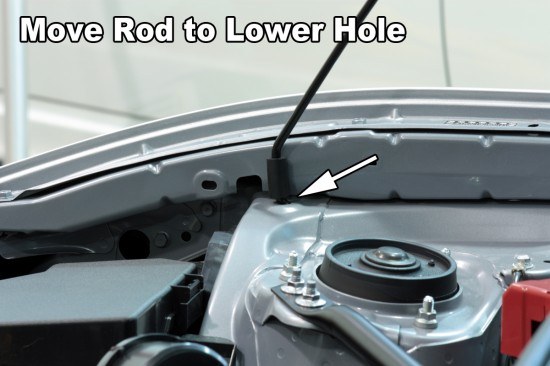 Love this tiny detail. I hate that the Subaru's with the hydraulic hood lifts don't clear most engine hoists when pulling out an engine. In this case, Subaru or Toyota got smart and added a hole here and another one on the hood to allow the hood prop to keep the hood up almost vertical.
Love this tiny detail. I hate that the Subaru's with the hydraulic hood lifts don't clear most engine hoists when pulling out an engine. In this case, Subaru or Toyota got smart and added a hole here and another one on the hood to allow the hood prop to keep the hood up almost vertical.
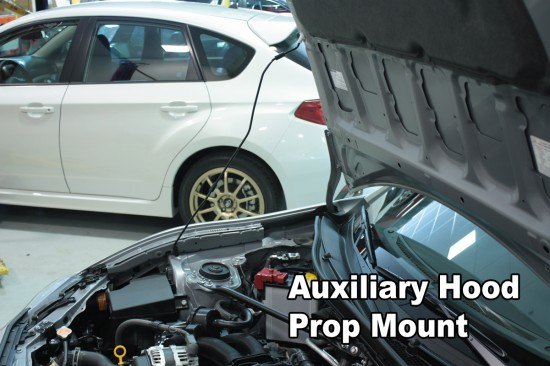 Love this!
The next thing I removed was the intake. One reason was to get to the crank pulley the other reason was to do some measuring for future intake pieces. (3) 10mm bolts and a couple of hose clamps and it was off.
Love this!
The next thing I removed was the intake. One reason was to get to the crank pulley the other reason was to do some measuring for future intake pieces. (3) 10mm bolts and a couple of hose clamps and it was off.
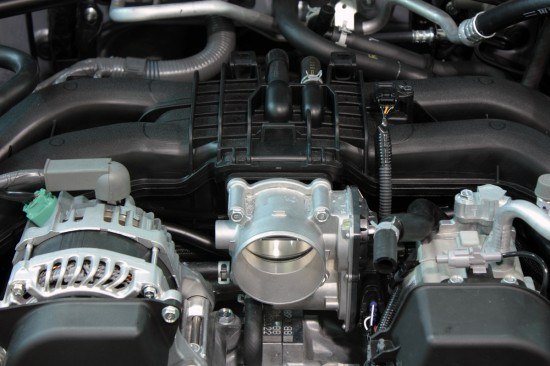 Here is good shot of the throttle body and top of intake manifold. I see a few people online are planning on replacing the throttle body, but this huge 3" OD throttle body should easily support the HP potential this has. The STI has a 2.75" OD throttle body for comparison.
Here is good shot of the throttle body and top of intake manifold. I see a few people online are planning on replacing the throttle body, but this huge 3" OD throttle body should easily support the HP potential this has. The STI has a 2.75" OD throttle body for comparison.
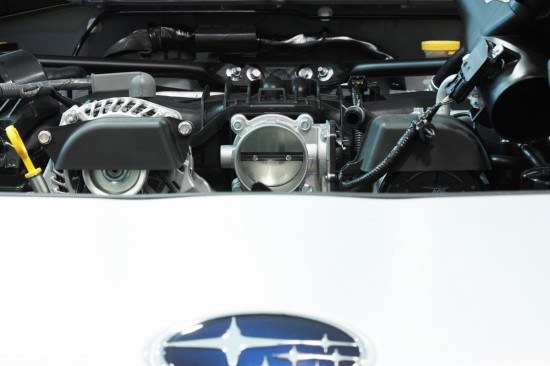 Here is a cool shot with the hood opened, intake removed. The throttle body clears the hood easily, but you can see potentially why Subaru put that little bulge in the hood. Mainly for style, but it does follow the line of the throttle body.
Here is a cool shot with the hood opened, intake removed. The throttle body clears the hood easily, but you can see potentially why Subaru put that little bulge in the hood. Mainly for style, but it does follow the line of the throttle body.
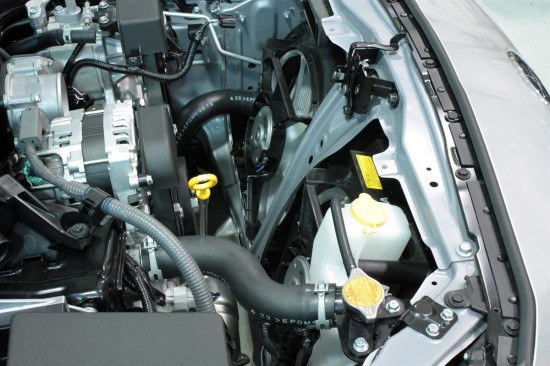 With the intake removed, the "V" mounted radiator and AC condenser can be seen. This is not something you see on normal cars. This is one of those little thing that was done to lower the height of the front of the car and make it more aerodynamic. Very cool feature for sure.
With the intake removed, the "V" mounted radiator and AC condenser can be seen. This is not something you see on normal cars. This is one of those little thing that was done to lower the height of the front of the car and make it more aerodynamic. Very cool feature for sure.
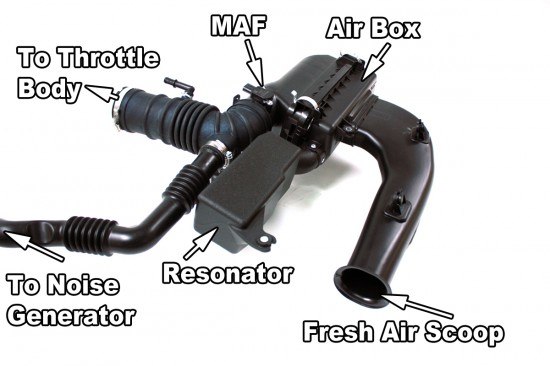 Here is a quick diagram showing what the intake system consists of. You can see its very short from the throttle body to the intake scoop. The fresh air scoop is behind the bumper right below the Subaru/ Scion/ FR-S logo. Its not a ram air by any means. Look for the PERRIN BRZ intake test and tune session where we really dig into the intake and making a proper one for the car.
Here is a quick diagram showing what the intake system consists of. You can see its very short from the throttle body to the intake scoop. The fresh air scoop is behind the bumper right below the Subaru/ Scion/ FR-S logo. Its not a ram air by any means. Look for the PERRIN BRZ intake test and tune session where we really dig into the intake and making a proper one for the car.
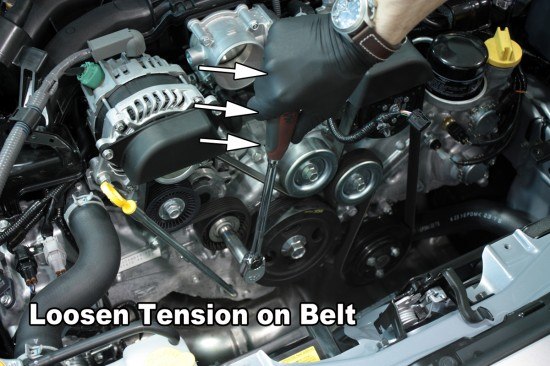 With the crank pulley now visible and accessible it was time to test fit a new part we had been working on, the PERRN Crank pulley. First thing to take note of, is the lack of manually adjustable belt tensioner. Removing the belt is a simple one tool operation. One multi-rib belt to do the job of driving all the accessories. All the Subaru fans out there will notice there is no power steering pump, but now a new water pump that is driven by the accessory belt. The power steering is all electric, and the pump for it is actually under the dash! Super cool. More pics on this later.
With the crank pulley now visible and accessible it was time to test fit a new part we had been working on, the PERRN Crank pulley. First thing to take note of, is the lack of manually adjustable belt tensioner. Removing the belt is a simple one tool operation. One multi-rib belt to do the job of driving all the accessories. All the Subaru fans out there will notice there is no power steering pump, but now a new water pump that is driven by the accessory belt. The power steering is all electric, and the pump for it is actually under the dash! Super cool. More pics on this later.
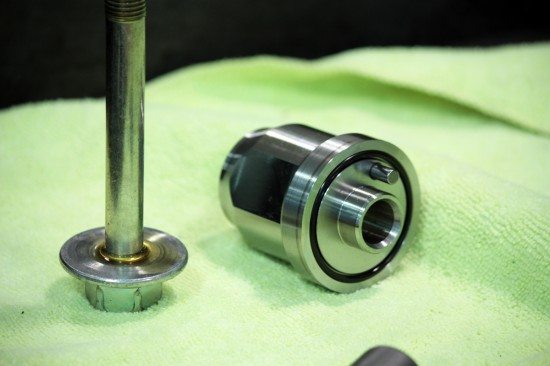 With removing the crank pulley, you will find this little nugget of fun. This piece is what actually seals on the front case of the engine. The crank pulley simply bolts to the face where that o-ring keeps oil from protruding out the crank bolt hole. This piece also is what drives the oil pump.
With removing the crank pulley, you will find this little nugget of fun. This piece is what actually seals on the front case of the engine. The crank pulley simply bolts to the face where that o-ring keeps oil from protruding out the crank bolt hole. This piece also is what drives the oil pump.
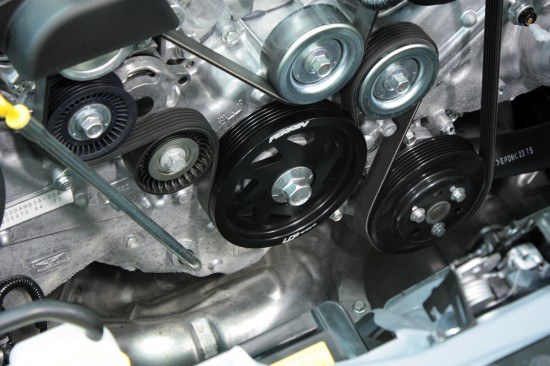 First actual purpose built BRZ/FR-S part! This part saves about 3.7lbs of the cranks rotating weight! We know that customers will really like the added response this provides!
First actual purpose built BRZ/FR-S part! This part saves about 3.7lbs of the cranks rotating weight! We know that customers will really like the added response this provides!
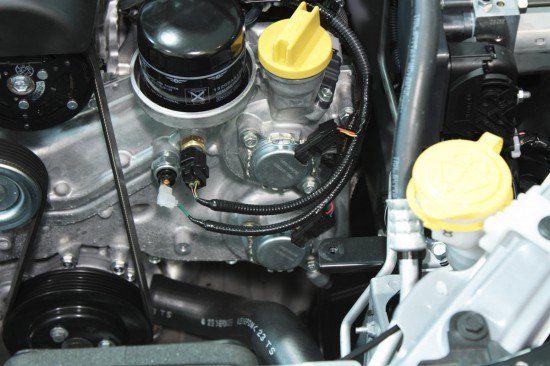 Very different than the other Subaru engines. The AVCS sensors and solenoids are setup quite differently. Going to the chain driven cams allows the AVCS mechanism to be slimmer and simply the solenoid and sensor setup. Also making for a much stronger engine in a front impact situation (EJ engines are known for cam, cam gear and AVCS mechanism failures in small front end collisions). Shown above are the AVCS solenoids mounted to the front cover.
Very different than the other Subaru engines. The AVCS sensors and solenoids are setup quite differently. Going to the chain driven cams allows the AVCS mechanism to be slimmer and simply the solenoid and sensor setup. Also making for a much stronger engine in a front impact situation (EJ engines are known for cam, cam gear and AVCS mechanism failures in small front end collisions). Shown above are the AVCS solenoids mounted to the front cover.
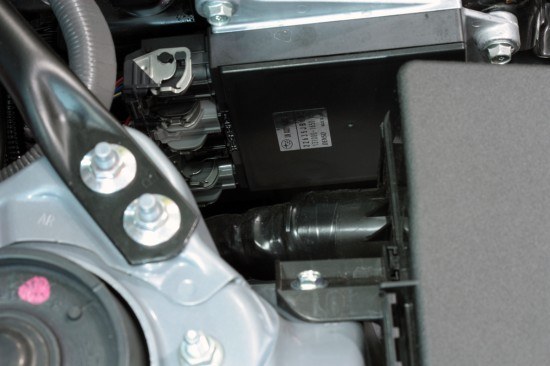 ECU in the engine! Yes but no. That is the injector driver unit. This is the unit that controls the high pressure direct injectors. So it is an ECU, but its not the main ECU that we are used to. That ECU is located in the passenger side compartment next to the glove box.
ECU in the engine! Yes but no. That is the injector driver unit. This is the unit that controls the high pressure direct injectors. So it is an ECU, but its not the main ECU that we are used to. That ECU is located in the passenger side compartment next to the glove box.
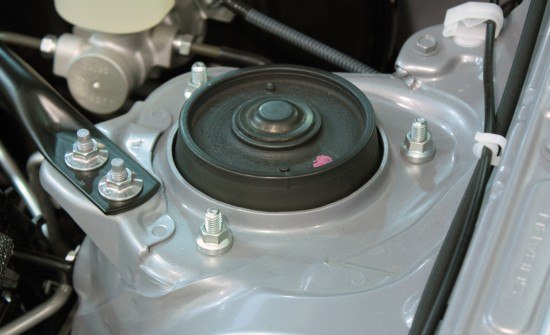 Its little things like this you find all over the car. Super long strut top studs. Super tall nuts as well. Its like they knew we would be making a strut bar for this car.
Its little things like this you find all over the car. Super long strut top studs. Super tall nuts as well. Its like they knew we would be making a strut bar for this car.
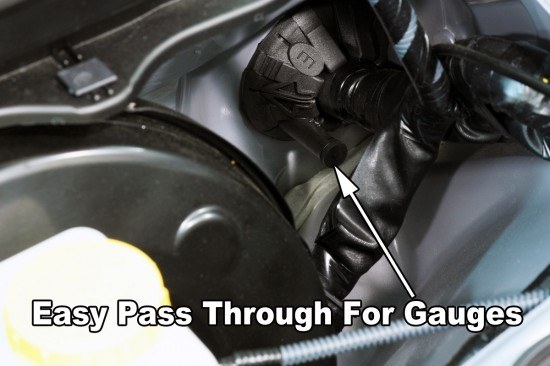 Another super cool detail. Again, they knew we would be installing gauges and needing to pass wires into the cabin. This rubber grommet and small tube are perfectly located for passing wires into the car. Even where they come through on the inside is easy to reach and out of the way. LOVE IT!
Another super cool detail. Again, they knew we would be installing gauges and needing to pass wires into the cabin. This rubber grommet and small tube are perfectly located for passing wires into the car. Even where they come through on the inside is easy to reach and out of the way. LOVE IT!
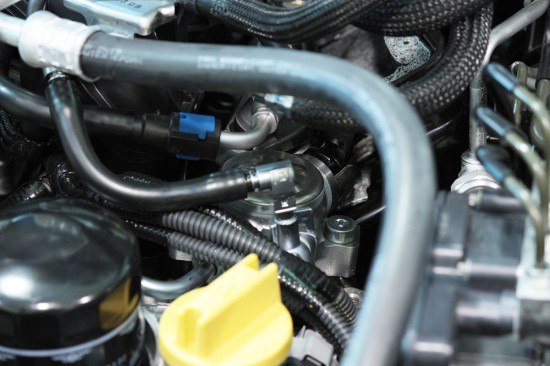 As most people have been reading, the new engine uses both direct injection and port injection. For these systems to work you must have a ultra high pressure fuel pump. This is not something that can done with an electrical pump but rather a mechanical pump. These are normally driven off the engine via a camshaft and its no different on the new Subaru engine. You can see it mounted here on the left head.
It still uses a fuel pump in the tank to push it up to the high pressure pump. From there its driven to the (4) injectors mounted in the cylinder head. For the normal port injectors, it uses a normal pump and rail system. Nothing special there, except there are 8 total injectors, which means there is plenty of capacity for running lots more HP. Since Subaru took so long to adopt this technology to their engines, lets hope they worked out all the bugs with failing pumps!
Now under the car.You can see the shielding under the car and panels installed to help keep the air flow smooth. What you can't see from the picture is how thick the pieces are.
As most people have been reading, the new engine uses both direct injection and port injection. For these systems to work you must have a ultra high pressure fuel pump. This is not something that can done with an electrical pump but rather a mechanical pump. These are normally driven off the engine via a camshaft and its no different on the new Subaru engine. You can see it mounted here on the left head.
It still uses a fuel pump in the tank to push it up to the high pressure pump. From there its driven to the (4) injectors mounted in the cylinder head. For the normal port injectors, it uses a normal pump and rail system. Nothing special there, except there are 8 total injectors, which means there is plenty of capacity for running lots more HP. Since Subaru took so long to adopt this technology to their engines, lets hope they worked out all the bugs with failing pumps!
Now under the car.You can see the shielding under the car and panels installed to help keep the air flow smooth. What you can't see from the picture is how thick the pieces are.
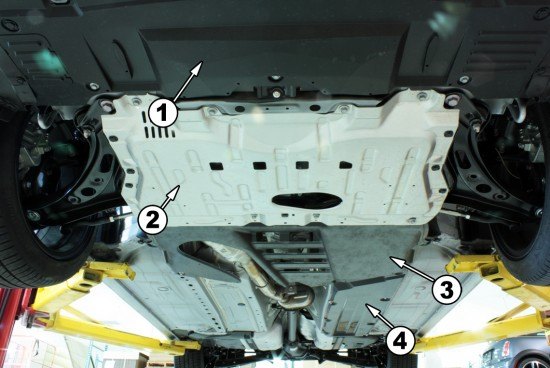 1- Large plastic shield- This is like most plastic splash guards, a little flimsy, but it does the job.
2- Thick Aluminum Panel- This piece is impressive. Its a skid plate more than anything because of how thick it is. At nearly 1/8" thick this piece is almost designed to be jacked up on. But its not. It was done to protect the super low engine and header. Other cars from Subaru do not have this, but that is because the engines are not as in danger of being damaged under normal driving conditions.
3- Fiberglass woven nylon panel- Almost like cardboard but its not. Another splash guard, but since its close the exhaust, its made from a material that will not melt over time.
4- One plastic under panel- This is the other cool part. The problem is its only on one side. In Japan, the BRZ comes with full under body paneling. We only get half that material. Best part is there are threaded holes on both sides to accepct the JDM parts
Before getting to the header (the part I am dying to see) I pulled the exhaust pieces off to weigh them.
1- Large plastic shield- This is like most plastic splash guards, a little flimsy, but it does the job.
2- Thick Aluminum Panel- This piece is impressive. Its a skid plate more than anything because of how thick it is. At nearly 1/8" thick this piece is almost designed to be jacked up on. But its not. It was done to protect the super low engine and header. Other cars from Subaru do not have this, but that is because the engines are not as in danger of being damaged under normal driving conditions.
3- Fiberglass woven nylon panel- Almost like cardboard but its not. Another splash guard, but since its close the exhaust, its made from a material that will not melt over time.
4- One plastic under panel- This is the other cool part. The problem is its only on one side. In Japan, the BRZ comes with full under body paneling. We only get half that material. Best part is there are threaded holes on both sides to accepct the JDM parts
Before getting to the header (the part I am dying to see) I pulled the exhaust pieces off to weigh them.
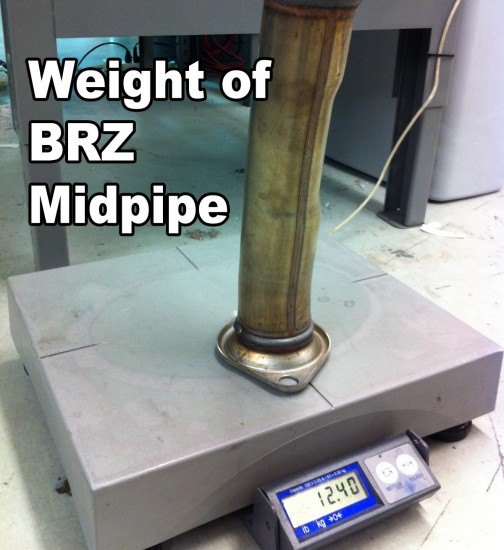
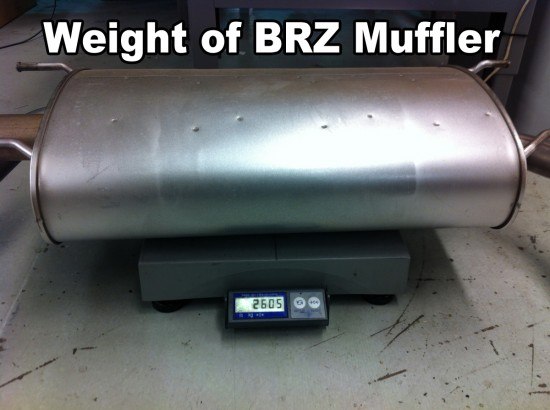 Not super heavy, but for sure there is room to improve this. Our prototype system comes in about 15lbs lighter, so we will see how this comes out in the end. The exhaust system on the BRZ comprises of 5 main parts. First is the Header, then Over Pipe (we came up with this name), Front pipe, Midpipe, then Muffler section.
Not super heavy, but for sure there is room to improve this. Our prototype system comes in about 15lbs lighter, so we will see how this comes out in the end. The exhaust system on the BRZ comprises of 5 main parts. First is the Header, then Over Pipe (we came up with this name), Front pipe, Midpipe, then Muffler section.
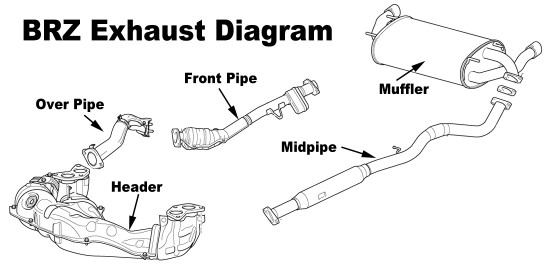 In the system there are two catalytic converters. One in the header (not replaceable), and one in the front pipe. Both styles are not high flow types so naturally, replacing these is high on our list.
In the system there are two catalytic converters. One in the header (not replaceable), and one in the front pipe. Both styles are not high flow types so naturally, replacing these is high on our list.
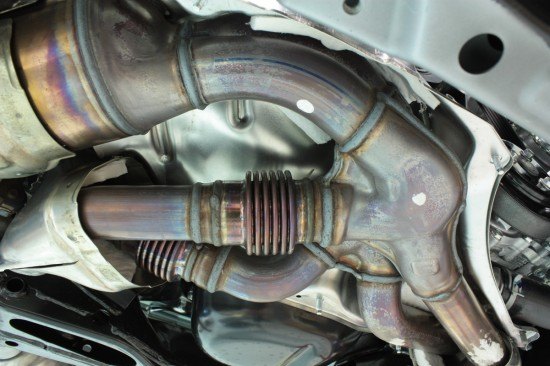
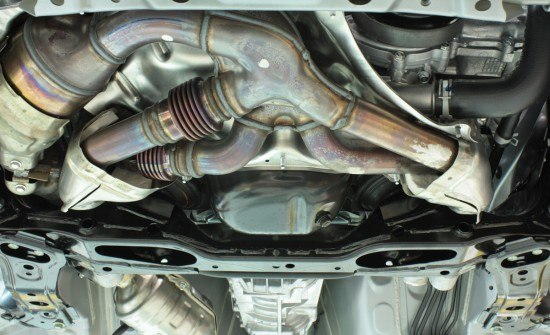 These are pictures with the shields removed from the header. You can see that its an equal length style header, but not with the best merge collectors. Its OEM, it gets the job done, and leaves room for us to improve. The tubing sizes is very good, but longer primaries and a better cat could net some pretty good gains.
These are pictures with the shields removed from the header. You can see that its an equal length style header, but not with the best merge collectors. Its OEM, it gets the job done, and leaves room for us to improve. The tubing sizes is very good, but longer primaries and a better cat could net some pretty good gains.
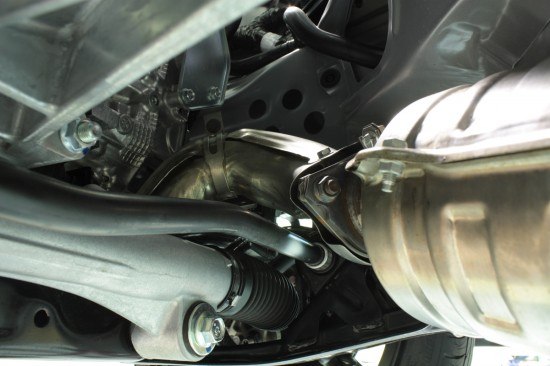 All us Subaru guys are very familiar with the Uppipe (not a term we came up with). This is the part that connects the header to the turbo on the WRX. This part was one of the first things people installed on their WRX when it came out. It would make about 10 Wheel HP because it replaced a restrictive part of the exhaust system. On the BRZ the Overpipe could be this same type of part. It amazing how tiny it is along with all the crazy bends and dimples to clear things. This part has to make a decent amount of HP.
All us Subaru guys are very familiar with the Uppipe (not a term we came up with). This is the part that connects the header to the turbo on the WRX. This part was one of the first things people installed on their WRX when it came out. It would make about 10 Wheel HP because it replaced a restrictive part of the exhaust system. On the BRZ the Overpipe could be this same type of part. It amazing how tiny it is along with all the crazy bends and dimples to clear things. This part has to make a decent amount of HP.
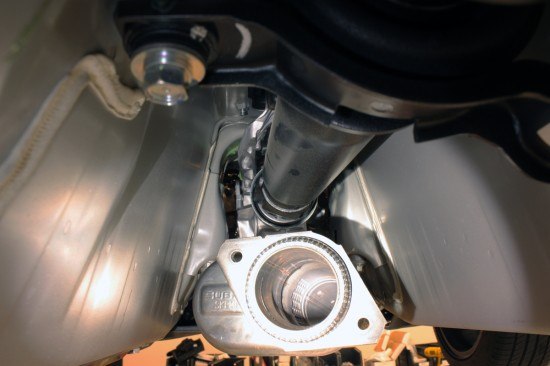 Here is a shot of the front pipe looking from the back into the tubing. The strange muffler you see here is made using a louvered type core. Besides it being small tubing, its not using a high flow type of core. Again showing there are some good HP gains to be had.
Onto the drivetrain stuff. Since we are looking at the headers already, its interesting to note the motor mount. Its the same type as the old 06 STI. Constructed of plastic, rubber and steel this is for sure something that you will want to replace. These are normally pretty soft so going with an STI, Group N, or even our new PERRIN Motor Mounts, might be a good upgrade.
Here is a shot of the front pipe looking from the back into the tubing. The strange muffler you see here is made using a louvered type core. Besides it being small tubing, its not using a high flow type of core. Again showing there are some good HP gains to be had.
Onto the drivetrain stuff. Since we are looking at the headers already, its interesting to note the motor mount. Its the same type as the old 06 STI. Constructed of plastic, rubber and steel this is for sure something that you will want to replace. These are normally pretty soft so going with an STI, Group N, or even our new PERRIN Motor Mounts, might be a good upgrade.
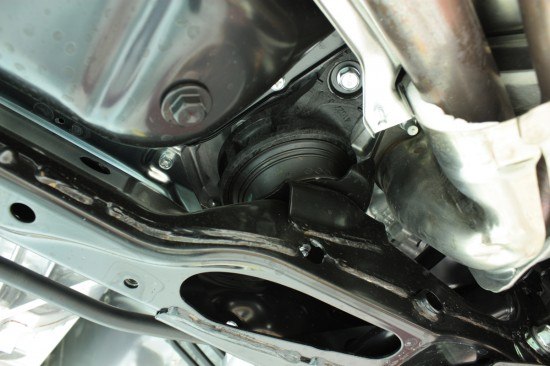
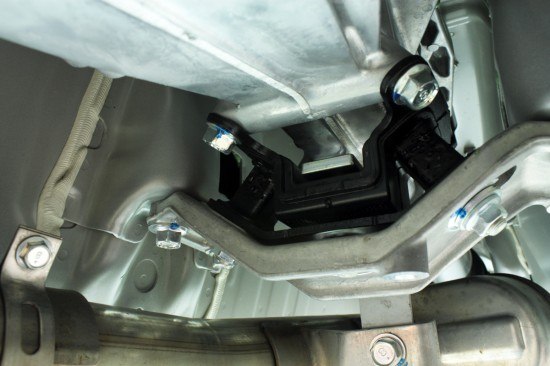 The rear transmission mount is very different from other Subarus. Its very small, and pretty flimsy. Another good part to upgrade for those looking to start bashing gears, or drifting where you want ZERO drivetrain slop. Since this is a whole new part for Subaru, we don't have anything that will instantly fit, but this is another part high on out list.
The rear transmission mount is very different from other Subarus. Its very small, and pretty flimsy. Another good part to upgrade for those looking to start bashing gears, or drifting where you want ZERO drivetrain slop. Since this is a whole new part for Subaru, we don't have anything that will instantly fit, but this is another part high on out list.
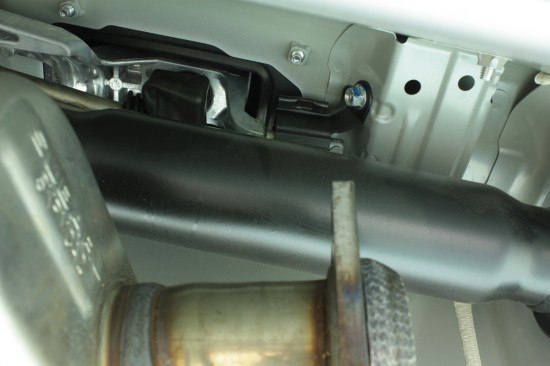 The shifter mechanism isn't always something you associate with drivetrain. For those not familar with Subarus, the shifter mechanism is connected to the transmission using two rods. One to hold it to the chassis and one to actuate the rod in the transmission. On the BRZ its constructed similarly, in that there is a really cool bracket that holds the shifter to the transmission, and a rod that actuates it. What is different is that its much more slimmed down over the WRX/STI versions. Also the "shifter bushings" are much smaller, much more dense. This is great for customers (maybe not for us) in that it provides a better feel from the shifter.
We know the shifter is short already. With the drift scene demanding longer shifters (putting the knob closer to the steering wheel) this will drive us to make a short throw shifter like we do for other cars.
The shifter mechanism isn't always something you associate with drivetrain. For those not familar with Subarus, the shifter mechanism is connected to the transmission using two rods. One to hold it to the chassis and one to actuate the rod in the transmission. On the BRZ its constructed similarly, in that there is a really cool bracket that holds the shifter to the transmission, and a rod that actuates it. What is different is that its much more slimmed down over the WRX/STI versions. Also the "shifter bushings" are much smaller, much more dense. This is great for customers (maybe not for us) in that it provides a better feel from the shifter.
We know the shifter is short already. With the drift scene demanding longer shifters (putting the knob closer to the steering wheel) this will drive us to make a short throw shifter like we do for other cars.
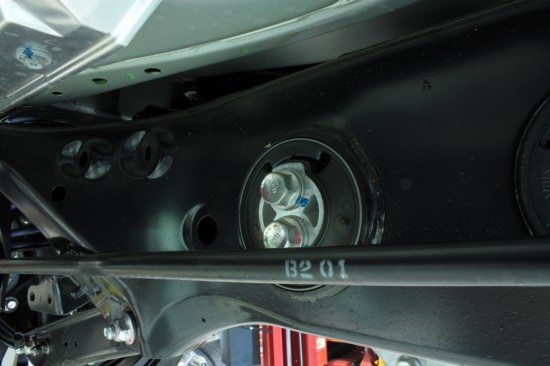 Subaru's rear subframe is very similar, but very different than the 08 STI/WRX parts. The subframe doubles as the diff carrier and you can see how the left side bushing is setup to help resist twisting of the diff under extreme conditions. Compared to previous Subaru's, the rear diff is mounted much more solid than the AWD cars. This makes sense since all the power is going to the rear wheels.
Subaru's rear subframe is very similar, but very different than the 08 STI/WRX parts. The subframe doubles as the diff carrier and you can see how the left side bushing is setup to help resist twisting of the diff under extreme conditions. Compared to previous Subaru's, the rear diff is mounted much more solid than the AWD cars. This makes sense since all the power is going to the rear wheels.
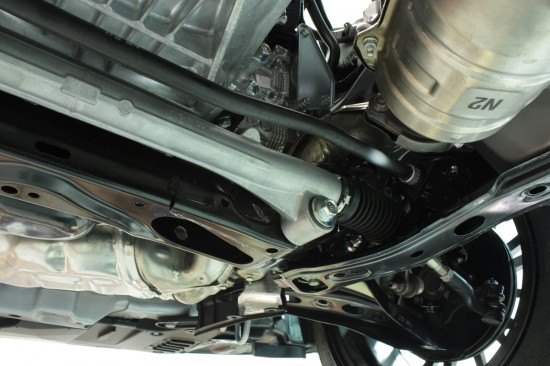 The front suspension is also very different. The control arms are backwards, there is a completely new front swaybar, new endlinks, and new steering rack. The under side of the BRZ is very clean because of all these new changes.
The front suspension is also very different. The control arms are backwards, there is a completely new front swaybar, new endlinks, and new steering rack. The under side of the BRZ is very clean because of all these new changes.
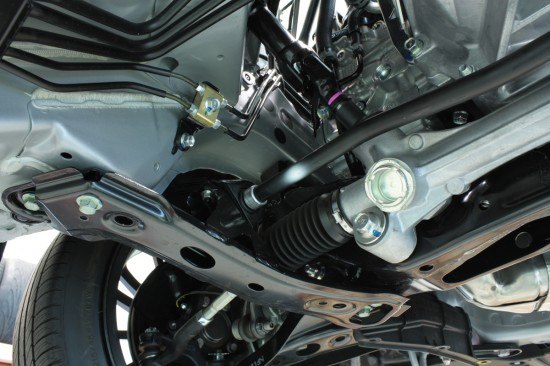 The front swaybar is a decent size (for the weight of the car) but for sure is an item we plan on making in different sizes. Maybe even softer for those who really want to turn their BRZ/FR-S into a drift car. This front swaybar is completely different than all the other swaybars for Subarus, and also different in that it can be removed without having to remove too many parts making this a simple upgrade.
In the above picture you can see how clean the underside of the car is with all the power steering stuff missing. Missing is all the normal power steering hydraulics, lines and other mess associated with mechanical type setups. Subaru got smart and installed an electric power steering pump, and then got even smarter and installed it on the steering wheel shaft inside the car. check out the diagram below.
The front swaybar is a decent size (for the weight of the car) but for sure is an item we plan on making in different sizes. Maybe even softer for those who really want to turn their BRZ/FR-S into a drift car. This front swaybar is completely different than all the other swaybars for Subarus, and also different in that it can be removed without having to remove too many parts making this a simple upgrade.
In the above picture you can see how clean the underside of the car is with all the power steering stuff missing. Missing is all the normal power steering hydraulics, lines and other mess associated with mechanical type setups. Subaru got smart and installed an electric power steering pump, and then got even smarter and installed it on the steering wheel shaft inside the car. check out the diagram below.
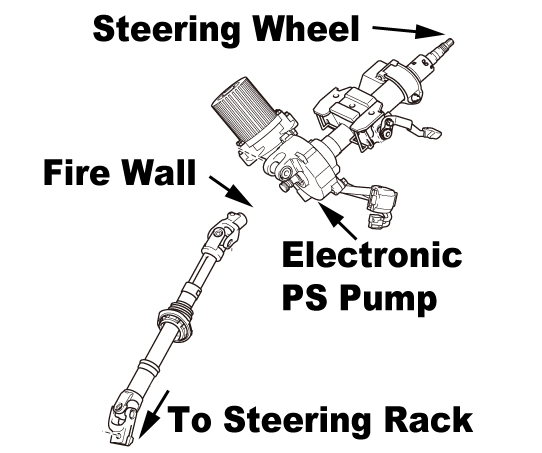 Here is a shot of the front struts and endlinks. The endlink is now connected to the strut and swaybar, not the control arm and swaybar like it used to be. I have my suspicions as to why they did this, but my guess is, it helps save some money in making the control arm slightly weaker, not having to deal with the forces of the endlink.
Here is a shot of the front struts and endlinks. The endlink is now connected to the strut and swaybar, not the control arm and swaybar like it used to be. I have my suspicions as to why they did this, but my guess is, it helps save some money in making the control arm slightly weaker, not having to deal with the forces of the endlink.
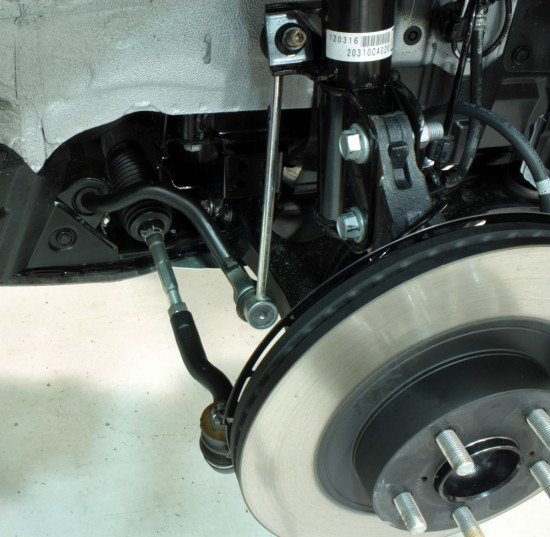 After pulling the strut out, the first thing i noticed was the camber bolts, or lack there of! Its amazing how a performance car/any car these days doesn't have a camber adjustment in the front. Its interesting because the OEM bolt has one side larger than the other, almost as though it was meant to be able to upgrade.
After pulling the strut out, the first thing i noticed was the camber bolts, or lack there of! Its amazing how a performance car/any car these days doesn't have a camber adjustment in the front. Its interesting because the OEM bolt has one side larger than the other, almost as though it was meant to be able to upgrade.
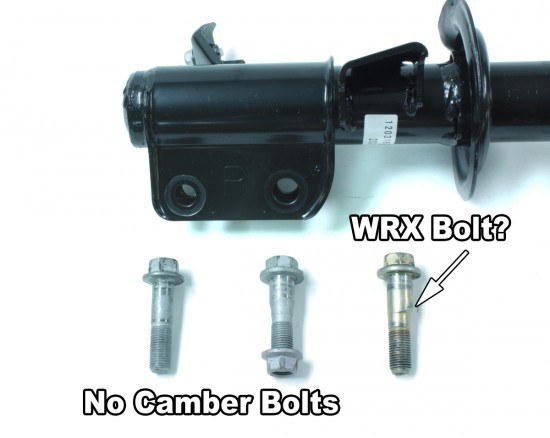 The WRX bolt did fit, and it did allow for some adjustment, but not enough. What did work perfect is an H&R camber bolt. Not sure how much adjustment this gives,but its got to be close to +or - 2 degrees. At this point its not a necessary item to have, but when we lower one of these, it will be.
The WRX bolt did fit, and it did allow for some adjustment, but not enough. What did work perfect is an H&R camber bolt. Not sure how much adjustment this gives,but its got to be close to +or - 2 degrees. At this point its not a necessary item to have, but when we lower one of these, it will be.
 The rear suspension is very similar to the 08-12 WRX/STI. There are couple of differences like the actual subframe is different. It's much stronger, to deal with all the power going to the rear wheels and also has a different cut out for the exhaust to pass through. This cutout makes the back of the car look a little crooked with no exhaust installed, which is a strange optical illusion. The upper control arms appear to be different as well compared to the STI. Still no camber adjustment! Hello Subaru, its only been FOREVER that you haven't made this adjustable!
Other notes about the rear, is the swaybar and endlinks. They are right off the 08+ cars, which is great for us as we do not have to make all new parts. The only problem is the stock swaybar is a 14mm, which makes our smallest swaybar HUGE for the BRZ. We do have available 19mm, 22mm and 25mm and soon a 17mm.
The struts and springs and the way they mount to the car is just like the 08+ cars, but completely different springs are used. Just like the older cars, the rear shock tops are super easy to get to. They are right under the carpet in the back.
The rear suspension is very similar to the 08-12 WRX/STI. There are couple of differences like the actual subframe is different. It's much stronger, to deal with all the power going to the rear wheels and also has a different cut out for the exhaust to pass through. This cutout makes the back of the car look a little crooked with no exhaust installed, which is a strange optical illusion. The upper control arms appear to be different as well compared to the STI. Still no camber adjustment! Hello Subaru, its only been FOREVER that you haven't made this adjustable!
Other notes about the rear, is the swaybar and endlinks. They are right off the 08+ cars, which is great for us as we do not have to make all new parts. The only problem is the stock swaybar is a 14mm, which makes our smallest swaybar HUGE for the BRZ. We do have available 19mm, 22mm and 25mm and soon a 17mm.
The struts and springs and the way they mount to the car is just like the 08+ cars, but completely different springs are used. Just like the older cars, the rear shock tops are super easy to get to. They are right under the carpet in the back.
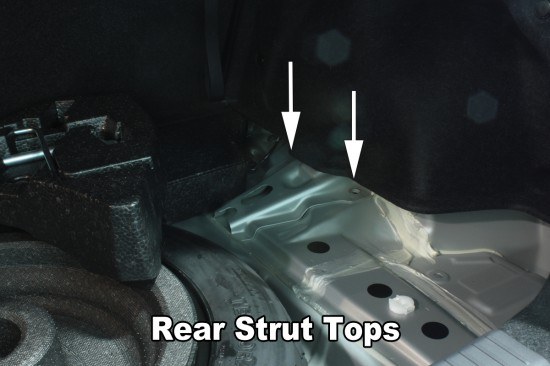
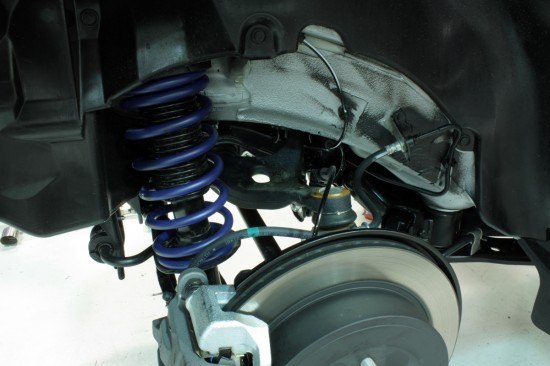 That is pretty much it for the important stuff. This is also a preliminary exploration, which means over the next few months, I am sure we will find lots more things. I am sure you are reading all this asking your self, what is PERRIN going to make for this? Its easier to say what we are NOT going to make. Bodywork/ground effects, wheels and tires. The rest is all up for debate. Even though there are so many good things about this car, there are lots of things to improve upon.
That is pretty much it for the important stuff. This is also a preliminary exploration, which means over the next few months, I am sure we will find lots more things. I am sure you are reading all this asking your self, what is PERRIN going to make for this? Its easier to say what we are NOT going to make. Bodywork/ground effects, wheels and tires. The rest is all up for debate. Even though there are so many good things about this car, there are lots of things to improve upon.
